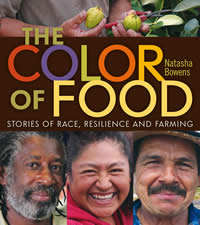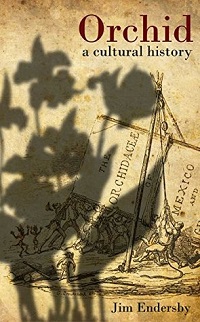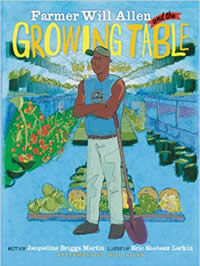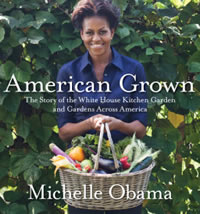 In describing her book, “The Color of Food,” Natasha Bowens explains, “I never would have imagined that my desire to dig in the dirt would lead me here, digging instead into the stories of farmers of color across America – Black, Latina, Native, and Asian farmer and food activists.” Initially, her interest in improving food and agriculture systems led her to working on organic farms, but often as the only “brown person” there. Through her blog (Brown.Girl.Farming), she discovers there are others like her, and decides their stories need telling.
In describing her book, “The Color of Food,” Natasha Bowens explains, “I never would have imagined that my desire to dig in the dirt would lead me here, digging instead into the stories of farmers of color across America – Black, Latina, Native, and Asian farmer and food activists.” Initially, her interest in improving food and agriculture systems led her to working on organic farms, but often as the only “brown person” there. Through her blog (Brown.Girl.Farming), she discovers there are others like her, and decides their stories need telling.
At the same time, she was learning about her heritage, including the uneasy discovery that her white mother’s ancestors owned her black father’s ancestors. “I’m literally the product of ownership and oppression reuniting, as if to rewrite the story.”
Her trip takes her across the country. For the purposes of this review, I’ll concentrate on stories she found amongst farmers on the West Coast. These include Menkir Tamrat, who came to the United States from Ethiopia for college in the 1970s and now lives in Fremont, California. Missing the special ingredients of the favorite dishes of his native land, he recognized that he would need to grow his own. This is what he does, but also enjoys preparing traditional dishes and some of the intermediate ingredients to sell to Ethiopian markets and restaurants.
In the Skagit Valley of Washington, Nelida Martinez is a Mixteca native – from the state of Oaxaca in Mexico – who now has her own organic farm focusing on raspberries, blackberries, and various vegetables. She made this bold move after her son sickened with leukemia, possibly from exposure to pesticides at the conventional farm where his mother once worked. She describes the experience of Latino farmworkers as “a lot of humiliation for us, and many of us never think about having our own farm because we feel degraded by the work.” Now, she is very pleased to not be working “for anyone else!”
Valerie Segrest is not a farmer in the traditional sense, but rather an advocate for the foraging traditions of her people, the Muckleshoot tribe based in Auburn, Washington. This includes cooking and eating traditional foods in season, a practice that has required compromises because of dams, pollution, or what she calls “European land management styles.” While she appreciates the role of conservation, she argues that the foraging and harvesting of native peoples ensured “a balance with nature where you’re working together and not having dominion over that space. Even as foragers, we use harvesting techniques that make it look like we’ve never even been there while also actually benefitting the plant.”
Excerpted from the Winter 2018 Arboretum Bulletin.
 Thomas Liptan introduces his new book,
Thomas Liptan introduces his new book, 
![[Garden Revolution] cover](https://depts.washington.edu/hortlib/graphix/GardenRevolution.jpg)
![[Sowing Beauty] cover](https://depts.washington.edu/hortlib/graphix/SowingBeauty.jpg)
![[Meconopsis for Gardeners] cover](https://depts.washington.edu/hortlib/graphix/MeconopsisforGardeners.jpg)
 The story of Will Allen and his urban farming non-profit organization (described in his book “The good food revolution”)has inspired a book found in the children’s section of the Miller Library. “Farmer Will Allen and the Growing Table,” written by Jacqueline Briggs Martin and illustrated by Eric-Shabazz Larkin, focuses on the role neighborhood children played in helping Allen’s enterprise be successful.
The story of Will Allen and his urban farming non-profit organization (described in his book “The good food revolution”)has inspired a book found in the children’s section of the Miller Library. “Farmer Will Allen and the Growing Table,” written by Jacqueline Briggs Martin and illustrated by Eric-Shabazz Larkin, focuses on the role neighborhood children played in helping Allen’s enterprise be successful. Michelle Obama needs no introduction and even her book “American Grown,” describing the White House Kitchen Garden she started, is already well known. For some, this may be an easy book to dismiss as a public service announcement, or worse, as a political statement. This is unfortunate, because it is a good gardening book, both for techniques and as a model of how gardening improves people’s lives in many ways.
Michelle Obama needs no introduction and even her book “American Grown,” describing the White House Kitchen Garden she started, is already well known. For some, this may be an easy book to dismiss as a public service announcement, or worse, as a political statement. This is unfortunate, because it is a good gardening book, both for techniques and as a model of how gardening improves people’s lives in many ways. In describing her book, “The Color of Food,” Natasha Bowens explains, “I never would have imagined that my desire to dig in the dirt would lead me here, digging instead into the stories of farmers of color across America – Black, Latina, Native, and Asian farmer and food activists.” Initially, her interest in improving food and agriculture systems led her to working on organic farms, but often as the only “brown person” there. Through her blog (Brown.Girl.Farming), she discovers there are others like her, and decides their stories need telling.
In describing her book, “The Color of Food,” Natasha Bowens explains, “I never would have imagined that my desire to dig in the dirt would lead me here, digging instead into the stories of farmers of color across America – Black, Latina, Native, and Asian farmer and food activists.” Initially, her interest in improving food and agriculture systems led her to working on organic farms, but often as the only “brown person” there. Through her blog (Brown.Girl.Farming), she discovers there are others like her, and decides their stories need telling. Will Allen grew up on a small farm in the Maryland suburbs of Washington, D. C. His parents grew up as sharecroppers in western South Carolina, very close to the home of J. Drew Lanham. As a young man, he was embarrassed by his heritage, instead hoping to make his career as a basketball player.
Will Allen grew up on a small farm in the Maryland suburbs of Washington, D. C. His parents grew up as sharecroppers in western South Carolina, very close to the home of J. Drew Lanham. As a young man, he was embarrassed by his heritage, instead hoping to make his career as a basketball player.